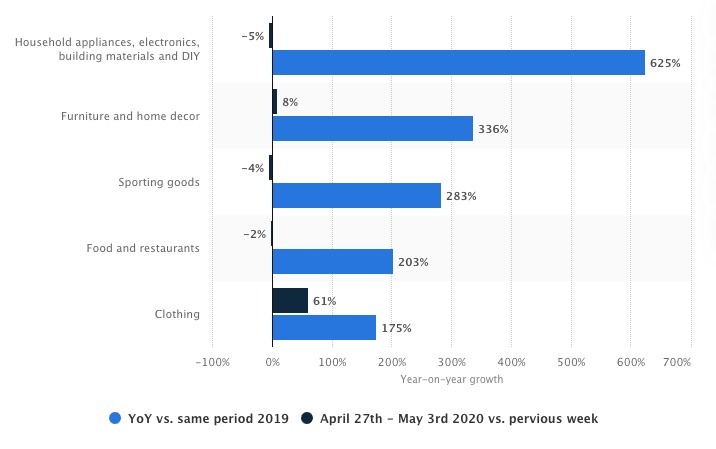Adapting Your Black Friday & Holiday Retail Marketing for 2020
This year has been a strange year to say the least. Many things and situations that we took for granted, such as going out for a meal, travelling, going on a vacation, getting together with our loved ones over a weekend, or having a drink at your favorite watering hole have been put on hold. Apart from the day-to-day indulgences, COVID-19 restrictions have also changed the way the world uses the Internet and how people are shopping online. In this article we will assess how COVID-19 has impacted the e-commerce and retail industry so far, and how it will likely affect the world as we enter the 2020 peak shopping season.

How COVID-19 Changed Shopping Behaviour Almost Overnight
One of the main consequences of COVID-19 was the overnight shutdown of non-essential brick and mortar stores and businesses. This led to panic buying/stockpiling of essentials such as sanitizers, disinfectants, groceries, baby products, etc. (we all remember the supermarket brawls for toilet paper!). However, there was also a massive shift to online e-commerce outlets to service the customer’s needs.
Shifting Consumer Behavior – A recent Google study suggests that more than 65% of shoppers in Canada are looking at more online avenues than in previous years, suggesting a significant change in their shopping behavior due to COVID-19. During the first lockdown, e-commerce retailers saw massive spikes in traffic and revenue, with some international retailers posting quadruple growth figures on household products over the same time period last year. At home in Canada, retail e-commerce sales reached a record $3.9 billion in May, a 2.3% increase over April and a 99% increase over February (~$2 billion). In some cases, this increase in online demand was even outpacing retailers’ ability to fulfill orders! The below graph from statista.com helps illustrate how key sectors such as electronics, food, furniture , etc., grew during the first lockdown:

Increased Brand Flexibility – Another trend that has recently emerged is a new willingness for consumers to try new brands. Google experts have suggested that in Canada, more than 30% of consumers shopped from a brand or retailer that they had not purchased from before this year. Also, about 66% customers are likely to shop at local small businesses to support the economy. This is a great opportunity for brands to grow new customers by simply being present with the right messaging, at the right time, in front of the right people (so long as they can fulfill the orders and keep up with demand). This has both huge potential for increased revenue in the short term, but also large customer lifetime value lift opportunities.
Consumer Behaviour Fundamentally Changed and Continues to Evolve
As per a Deloitte Canada study, even before the first wave of lockdowns were officially in place, consumers were preparing by making less visits to crowded spaces like public transport hubs, places of work, restaurants, cinemas and shopping centers. As per this study, 42% of Canadians started to avoid trips to the mall, 32% cancelled trips to the movies, 31% skipped trips to the gyms, 22% avoided public transport and 20% skipped plays and concerts. 75% of Canadian consumers say they are maintaining a safe distance from other people, with 36% of all respondents turning to self-checkout machines. About 54% of Canadians confirm that they cancelled plans in order to comply with social distancing orders.
By May/June 2020, cases from the first wave were decreasing, and brick and mortar stores started to reopen. However, many brands saw that in-store traffic and sales were still down over the previous year.
We come to today, where a Google survey suggests 74% of shoppers intend to plan their shopping earlier to avoid crowds, while 82% of planned shoppers will consolidate their shopping to make fewer trips than they did in previous years. Especially with new restrictions due to the second wave, COVID will definitely continue to change Canadian spending habits for weeks and months to come.
Canadian Consumers are also looking for safer ways of giving gifts to their loved ones this year. According to a Google survey, 66% of Canadians plan to give out more gift cards rather than gifts this year than in previous years. These are significant numbers representing a large portion of the population, indicating a fundamental change in behavior. It would be a safe assumption that while things are getting better, user behavior won’t be returning to “normal” anytime soon. When we look at our e-commerce clients at Vovia, we are still seeing large (over 100%) revenue gains year over year, which means there is likely more opportunity for online retailers to drive revenue during the peak shopping season than ever before!
How You Can Tackle Marketing Strategies for the 2020 Holiday Season
Offering shopping options is key – Traditionally, big sale days such as Black Friday and Boxing Day saw customers camping in front of stores for hours before the sale and literally stampeding in when the stores open to save $5 on a toaster; this year could very well be a departure from that tradition. While many stores are stringently implementing government mandates of social distancing, brands should be prepared to give customers alternative options such as curbside pickup, which has seen a 3000% increase in search demand since last year. Even if you don’t have an e-commerce store, this can be something you can leverage. This is especially true with many provinces implementing new restrictions creating less opportunity for in-store shopping and the suggestion that in-store shopping is a higher-risk activity.
Stretch out your sales to manage demand / inventory – Many retailers might go the other way and not have in-store Black Friday / holiday deals at all this year, with major retailers such as Walmart, Best Buy, Kohl’s and Target announcing that they will be closed this (American) Thanksgiving. If that’s not in the plan for your brand, some retailers are spreading big sales out over a period of a few weeks instead of a particular day to reduce the peak period crowd both online and in-stores. One such example is Home Depot, which effectively canceled its traditional Black Friday this week. Instead, it will offer Black Friday discounts beginning in early November and continue the deals into December.
Prepare to heavy-up your media spends, especially if you sell online – When it comes to online shopping, we are seeing many brands getting ahead of the game and releasing their deals early (some retailers like Best Buy released their flyer in October!) as well as more spending from an advertising perspective earlier in the month. Smart and savvy marketers will have shored up their spends to provide a lift for the expected increase in online shopping behaviour, and perhaps they are even offering online-only incentives.
Continue offering deals throughout the year – People are still very much in the market for Black Friday / holiday deals. This is evident from the data seen in a Google survey, where around 6 in 10 Canadian shoppers still expect retailers to offer them discounts when shopping with them online at this time. Canadian women tend to be more enticed by sales offers than men (61% Women vs. 58% Men), with 63% of 35-44-year-olds being most likely to purchase a discounted item. This would point to the fact that while COVID-19 may have changed the way the world works, “retail therapy” isn’t going anywhere and there is still a large appetite for consumers.
One of the biggest challenges for marketers this year is accept and analyze the ongoing behaviour changes. Successful marketers will stay on top of the latest changes and build flexible strategies that can adapt to this ever-evolving situation. We know it’s not easy, but if you can find ways to be present where people are looking, provide value through competitive pricing and options to deliver goods and services, you will be set up for success this peak season.
We’d love to hear how you are (or have been) preparing for the changes to shopping behaviour this year. Want to bounce ideas off of us? Drop us a line at info[at]vovia.com, or connect with us on social!
